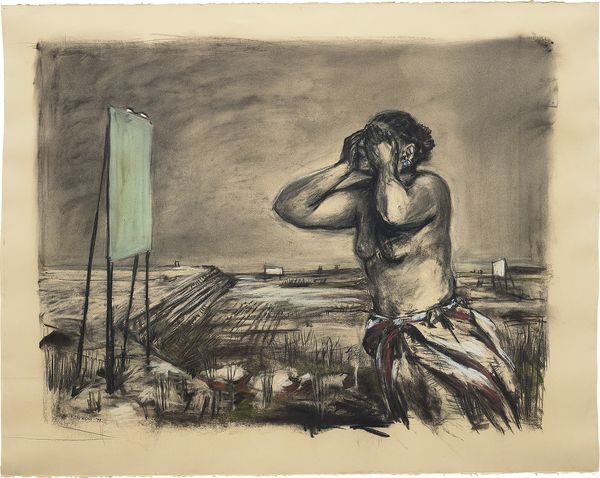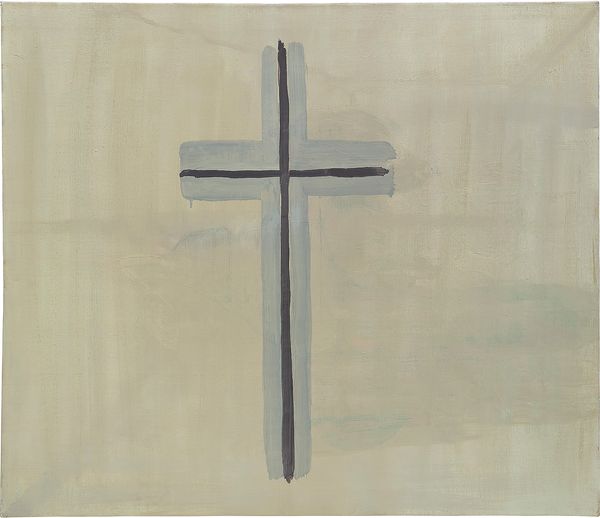Works from the New Now auction on view at our Berkeley Square London headquarters.
Both recipients of prestigious European solo exhibitions in 2019, William Kentridge and Luc Tuymans are known for incorporating the study and practice of filmmaking into their formidable oeuvres. The artists, born only three years apart, each mediate painful memories that have ingratiated themselves into their respective national cultures through their work. For South African-born Kentridge, these themes include colonialism and Apartheid, while Tuymans, a Belgian, has examined religious conservatism and the lasting legacy of Nazism’s rise in Europe. Working through existing materials such as drawings and film stills, Kentridge and Tuymans have each drawn from their unique experiences to create a body of work that critically examines the very making of art within the larger cultural and political discourse.
William Kentridge Drawing for Felix in Exile (Nandi's Cry), 1993. Estimate: £150,000 - 200,000. New Now at Phillips London, 12 December.
Covering a wide breadth of genres – animation, drawing, collage, performance – Kentridge’s creations come close to what German opera-composer Richard Wagner named the ‘Gesamtkunstwerk’: the synthesis of various or all art forms. Known for his complex drawing method consisting of laying bare erasures, smudges and altered forms, as well as exposing a sketch’s multiple compositional recesses, the artist has built an oeuvre that defies categorization, distinctly tied to draughtsmanship while simultaneously living on the cusp of cinematic dynamism. This multifaceted approach was explored in Kentridge's 2019 exhibition, A Poem That Is Not Our Own, at the Kunstmuseum Basel, which delineated the multiple points of connection between drawing and filmmaking in the artist's oeuvre. In the present work, Drawing for Felix in Exile (Nandi's Cry), 1993, the artist has alluded to both static and moving media, utilizing the central image from an animation picture he was concurrently working on from September 1993 to February 1994, entitled Felix in Exile – today residing in such eminent institutions as the Tate Collection, London, the Museum of Modern Art, New York, and the Guggenheim, New York. Although the present work was not used as a working animation sequence in Felix in Exile, it provides a compelling peek into the film’s narrative, which conveys themes of memory and loss within a geo-political landscape.
Felix in Exile was the fifth of nine films Kentridge completed in his Drawings for Projection, conceived between 1989 and 1999. Within the series, each sequence from each film had been altered and photographed in 16 or 35mm film, remnants of successive stages later remaining on paper as independent drawings. In Felix in Exile, the character of Nandi was introduced for the first time; she initially appears mapping the history of the terrain surrounding her – Johannesburg’s East Rand, where dilapidated mines and factories have created a landscape of nostalgia and loss. She is presented as a witness, a surveyor, a presence to record events in a world otherwise silent. Notably, Felix in Exile was conceived amidst ongoing public debates on the relationship between the country’s division of ownership and the formation of identity which accompanied the first open elections in South Africa. The present work thus tells a story of identity, hopes and fears for a new future. In it, the titular protagonist has concealed her eyes with her hands, in an act that seems desperate or ‘brought about by the process of painful remembering’ (Elizabeth Manchester, ‘Felix in Exile’, Tate). She summons fraught notions of memory and collective identity, further vivified by Kentridge’s gestural marks, shadows and smudges. The temporal traces of his hand emulate a danse macabre of absence and presence, foreshadowing the protagonist’s death in successive stages of the film. Nandi is thus a critical drawing where form exquisitely meets meaning, encapsulating the talent with which Kentridge creates all-consuming narratives.
Luc Tuymans Cross, 1987. Estimate: £80,000 - 120,000.
New Now at Phillips London, 12 December.
Currently the subject of a highly acclaimed monographic exhibition at the Palazzo Grassi, Venice, Tuymans has become known to the public as a contemporary master of figurative painting, infusing his work with an unknowable, dreamlike quality that moves beyond habitual modes of representation. Cross, 1987, is a striking example of the artist’s deeply atmospheric style. It presents an iconic sign – the eponymous Christian cross – on a subdued background of pearl-grey paint. The image – clean, simple, and rendered with eerily frosty tones – continues Tuymans’ investigation of the subject of religion, whereby he has repeatedly questioned the meaning of text, signs, and the loose connection between image, memory and reality to identify the point where spirituality and collective critique collide. Religion, in Tuymans’ artistic syntax, is indissociable from socio-political context; here, Cross transcends its iconographic premise to reach a wider historical realm, prompting the viewer to ponder the multitude of interpretations that can be carried by a single symbol. As such, the work resonates with his wider body of work which, in the variety of themes it addresses, constantly seeks to depart from the simplistic appearance of an iconographic source.
Executed just two years after Tuymans had come back to painting from a five-year hiatus, Cross demonstrates the artist’s unique painterly approach at a time when his interest in form was equal to that in subject matter. Focusing intently and seemingly exclusively on the central symbol, Tuymans is here able to "make people reconsider what they’re seeing" (Luc Tuymans, quoted in Dorothy Spears, ‘Putting the Wrongs of History in Paint’, The New York Times). Yet, transcending the object’s crystal-clear delineation, Cross additionally attests to Tuymans’ capacity in invoking light through an unparalleled mastery of color and contrast. With its washed-out backdrop, the composition conveys a multitude through minimalism, realism through cinematic synthesis. As a result, a powerful luminosity bleeds beyond the canvas’ margins, as if the cross were sheltering a host of light that could outshine the symbol’s perpendicular structure. Moving beyond its modest appearance, Cross glows with a numinous force – deeply luminescent in form; it is an exceptional example of Tuymans’ oeuvre, which amidst flurries of celebration, was most recently picked to fill the space of the Palazzo Grassi to coincide with the 58th edition of the Venice Biennale.
Both of these works will be offered this month in our London New Now sale. Currently on view in 30 Berkeley Square, the auction will take place on 12 December and also features pieces by Jonas Wood, Damien Hirst, Katharina Grosse and many others.


